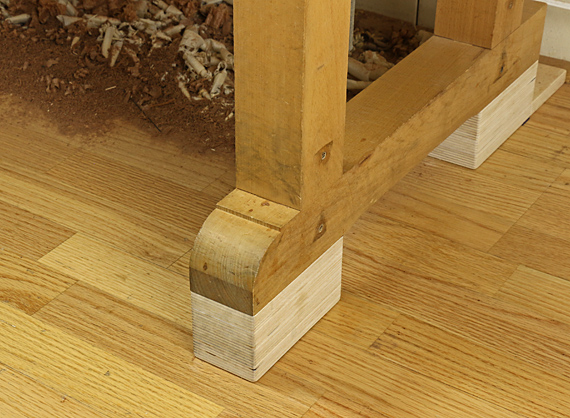
In a 2011 post, I argued for an empirical approach to determining your best workbench height instead of relying on any formula. The many variables in body characteristics, woodworking styles, and tools necessitate practical testing.
Consider the tasks you do at the bench, such as planing, sawing, and chiseling, and the portion of time and effort you are likely to devote to each category. Then find a workbench, Workmate, or a sturdy table to try the work at different heights created by clamping layers of boards or plywood to the table. Find what feels best all-around.
Maybe your ideal bench height will change over time as mine has. Recently, after assessing how I was working, and then testing just as I recommend to others, I raised my bench almost two inches to 37″. I feel more comfortable overall, particularly being able to stay closer to a neutral head posture. I can reduce the bend in my neck, which reduces stress on the lower cervical vertebral joints.
On the other hand, I can feel that the higher bench height transfers more of the work of certain tasks such as heavy planing to my upper back and arms. Fortunately, I’ve maintained good upper body strength, especially in the upper back and shoulders, so I don’t seem to miss the reduced drive from the ground. In fact, firming my upper back as I work actually further removes stress from my neck.
I used long #14 screws to attach a glued stack of Baltic Birch plywood to the base of the bench, replacing the previous riser blocks. 3M Safety-Walk slip resistant tape applied to the bottom along with filler blocks between the bench and the back wall do a great job of keeping the bench stable in all directions.
“Assess your stress” and work habits to make your shop time more efficient and pleasant.


I’m curious, is the distance between your bent elbow and the top of your bench 4″ to 4.5″?
Hi Bob,
I don’t know. I never measured it because functional comfort and efficiency matter to me, not numerical rules.
OK though, I’ll measure it. Be right back.
I’m back. Yea, about 4 1/2″.
Maybe that will help as a starting point for testing different heights with different tasks.
Rob
Thank you for checking. That is starting to look like a reliable starting point for bench height for modern hand tool woodworkers.
I did a quick survey of workbenches including Ulmia, Sjobergs, Hoffman and Hammer, and Ramia. The benchtop heights in the full-size models range from 34 1/4″ to 35 1/2″. These will probably be too low for most male woodworkers, at least in the younger generations. However, it is easier to raise a bench than to lower it, so it does make sense that the manufacturers are starting a bit low for most customers.
Then there are the Lie-Nielsen benches for which you can order to a custom height.
Rob
What height is this based on? Most recommendations are for 37” bench height for people around 5’10” tall. At 5’ 3” this seems too high for me. Haven’t found much specific information for shorter people. Looking to build a bench shortly. Thanks for any input.
Fran,
I’m 5’9″ and stopped growing somewhere around a half century ago, haha.
But again, I strongly suggest avoiding specific bench height recommendations or formulas. Look at my 2011 post (see link in this post) and try that process to get a sense of what works for you. It’s invaluable.
Bob’s suggestion (above) for just a starting point may shorten the trial and error process.
Good luck.
Rob
Rob,
I agree there are too many variables to a good working height for a height based rule to work. For example I’m 5’8″ but built like an ape with short legs, long body and arms. I just did a quick check of my bench: Slab height 34 1/4″, bottom of elbow to bench top 6″. IIRC the first bench I build was about 36″ which also IIRC was the recommended height for my height. Over the years and new builds I’ve settled on ~34″ as the correct height. An inch or two can make a big difference in comfort.
ken
Good example. Thanks, Ken.
Rob
There is always going to be the exception and that is fine. I’ve been looking at this for a long time and none of it is my invention , but tidbits of others wisdom. The other guide that seems to be good is:lower back pain- bench too high. Neck pain- bench too low. It may be only 1/4″ off, but for most people this seems to get to good results. There aren’t any hard fast rules so your mileage may vary, as they say.